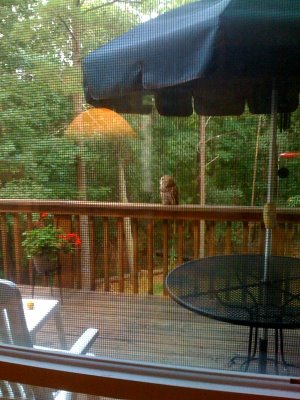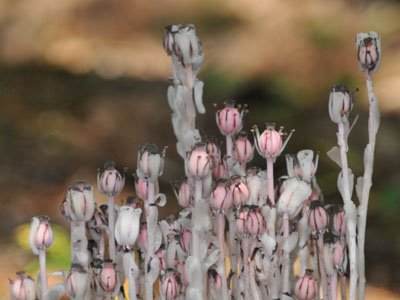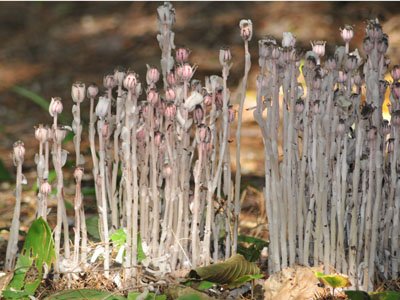Golden-winged Warbler, Black-throated Green, Bay-breasted and More – A Colorful Wave of Fall Migrants Passing Through
Friday, October 10th, 2008When I first stepped outside this afternoon around 4:15, the trees around our house seemed quiet, with no hint of what was to come. The sky had recently cleared after a cloudy, gray morning and two days of rain, and it was warm, sunny and breezy. The woods still looked green, though many leaves had washed down in the rain. At first, I heard only the wind in the trees, a few Blue Jays, Titmice and Chickadees, and the rattle of a Red-bellied Woodpecker.
A Hairy Woodpecker announced its arrival among a stand of dead and dying pines and set to work. A Pine Warbler sang, and then I heard the call of a Summer Tanager somewhere nearby, but out of sight. Its soft, repeated pik-a-tuk was the first sign of what would turn out to be one of the most amazing hours of birding I’ve ever experienced.
Some movement in the branches of an oak turned out to be a Tennessee Warbler, giving occasional faint tssit calls. A small, quick-moving bird with a smooth, almost velvety olive back and wings, a white breast and belly, and a delicate, pale streak above its eye, it stayed in constant motion, mostly hidden among the foliage as it gleaned insects and spiders from under the leaves, often turning upside down, and occasionally emerging long enough for me to see it well – before it disappeared into the depths of a large dogwood tree.
As I turned away, a much larger, slender bird with a long tail flew into the top part of a tall young oak. It was mostly hidden among the leaves, but as it moved up higher, I could see a pale breast and a haughty profile with a large, curved bill – then it flew right into a branch in the white oak beside the deck where I was standing, and perched in full view – a Yellow-billed Cuckoo. It was silent, but gave me an unusually close-up view of its sleek shape, creamy white throat and breast, smooth brown back, and the dramatic underside of its long tail, black with big white spots. I could even see whiskers or bristles around the yellow bill, though I can find no reference to them in species accounts and descriptions.
Another small, compact bird in one of the oaks turned out to be a Chestnut-sided Warbler. With a greenish head and back, two yellowish wing bars, and a white eye ring, it was one of the easiest migrants to see, staying relatively low in the branches and often coming into full view as it darted from spot to spot. From that point on, the trees suddenly seemed to be filled with warblers and vireos, and for the next hour and a half or so, I couldn’t move fast enough to see them all: Yellow-throated Vireo, Blue-headed Vireo, and Bay-breasted, Yellow-throated, Magnolia, and Black-throated Green Warblers – and last, but most exciting for me, a vivid, close-up view of a Golden-winged Warbler. All were very active, many brightly colorful, and most were so intent on foraging that I was able to watch them for several minutes.
The Yellow-throated Warblers were perhaps the showiest of the group, frequently hawking insects from the ends of high branches in the oaks. Their heads were constantly turned up, showing off long necks, long thin bills, and flaming yellow throats, set off by ink-black markings around the face and eyes and down the sides. The Bay-breasted Warblers, in contrast, looked sturdy and rather stolid, moving much more deliberately through the branches to catch caterpillars, and then sitting quietly to eat each one. The ones I saw were males in handsome fall plumage, with greenish head and back, white wingbars, a yellowish face and subtle dark streak through the eye, a faint but distinctive pattern of streaks on the back, and a wash of reddish-brown on the flanks.
A Black-throated Green Warbler perched in the top of an oak as if posing, with its yellow face glowing in sunlight, and the black of its throat and upper breast bleeding down its sides in thick streaks. Caterpillars seemed to be the main attraction for both the Yellow-throated Vireo and Blue-headed Vireo, but also some flying insects. The Yellow-throated Vireo more often stayed screened in the foliage, and I only caught quick glances of its yellow throat, yellow spectacles, blue-gray wings with delicate bars, and white belly. The Blue-headed Vireo moved more often out into the open and stayed lower in the trees, moving from branch to branch, unmistakable with its slate-blue head and striking white spectacles.
Meanwhile, Magnolia Warblers fluttered like butterflies, flashing yellow rumps and white tail-bands, recognizable even from directly below, with their yellow breasts, and tails that are white underneath and tipped with a thick, dark charcoal band. There were so many birds that I felt as if I couldn’t move fast enough to see them all – but at the same time, it was hard to tear myself away from watching each one.
Just when I thought surely it couldn’t get any better, I saw a very brightly patterned bird curled around the leaves at the end of a low branch in a water oak. I’m sure my mouth fell open in disbelief as I noted each of the field marks – gray back, rich yellow-gold crown, white face, black mask and throat, and thick, gleaming gold bar on the wing – it was a Golden-winged Warbler, a life bird for me, and a songbird whose populations are in serious decline. It looked small and round and neat, a little ball of intense patterns of color, moving in an almost chickadee-like way as it probed and gleaned insects from the leaves, and it stayed in full view for several minutes.
Then suddenly, it was over. When the Golden-winged Warbler flew, I looked around, and watched two Yellow-throated Warblers hawking insects again. But when they disappeared, I could find no more. One minute they were there – the next, they were gone.


